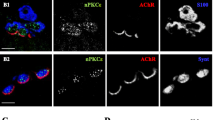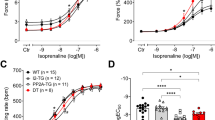Abstract
We have studied the association between M3 muscarinic acetylcholine receptors (M3-mAChR) and protein kinase C-ε (PKC-ε) during ischemic myocardial injury using Western blot analysis and immunoprecipitation technique. Myocardial ischemia (MI) induced PKC-ε translocation from cytosolic to membrane fractions. This translocation participated in the phosphorylation of M3-mAChR in membrane fractions, which could be abolished by the inhibitor of PKC, chelerythrine chloride. On the other hand, M3-mAChR could also regulate the expression of PKC-ε in ischemic myocardium. Choline (choline chloride, an M3 receptor agonist, administered at 15 min before occlusion) strengthened the association between PKC-ε and M3-mAChR. However, blockade of M3-mAChR by 4-diphenylacetoxy-N-methylpiperidine methiodide (an M3 receptor antagonist, administered at 20 min before occlusion) completely inhibited the effect of choline on the expression of PKC-ε. We conclude that the translocation of PKC-ε is required for the phosphorylation of M3-mAChR; moreover, increased PKC-ε activity is associated with M3-mAChR during MI. This reciprocal regulation is likely to play a role in heart signal transduction during ischemia between ventricular myocytes.





Similar content being viewed by others
References
Budas GR, Mochly-Rosen D (2007) Mitochondrial protein kinase Cε (PKCε): emerging role in cardiac protection from ischaemic damage. Biochem Soc Trans 35:1052–1054
Cain BS, Meldrum DR, Harken AH (1999) Protein kinase C in normal and pathologic myocardial states. J Surg Res 81:249–259
Cascio WE, Yang H, Muller-Borer BJ, Johnson TA (2005) Ischemia-induced arrhythmia: the role of connexins, gap junctions, and attendant changes in impulse propagation. J Electrocardiol 38:55–59
Chen L, Hahn H, Wu G, Chen CH, Liron T, Schechtman D, Cavallaro G, Banci L, Guo Y, Bolli R, Dorn GW 2nd, Mochly-Rosen D (2001) Opposing cardioprotective actions and parallel hypertrophic effects of δPKC and εPKC. Proc Natl Acad Sci U S A 98:11114–11119
Disatnik MH, Buraggi G, Mochly-Rosen D (1994) Localization of protein kinase C isozymes in cardiac myocytes. Exp Cell Res 210:287–297
Doble BW, Ping P, Kardami E (2000) The ε subtype of protein kinase C is required for cardiomyocyte connexin-43 phosphorylation. Circ Res 86:293–301
Goodnight JA, Mischak H, Kolch W, Mushinski JF (1995) Immunocytochemical localization of eight protein kinase C isozymes overexpressed in NIH 3 T3 fibroblasts. Isoform-specific association with microfilaments, Golgi, endoplasmic reticulum, and nuclear and cell membranes. J Biol Chem 270:9991–10001
Gordon AS, Yao L, Wu ZL, Coe IR, Diamond I (1997) Ethanol alters the subcellular localization of δ- and ε protein kinase C in NG108-15 cells. Mol Pharmacol 52:554–559
Guo D, Nguyen T, Ogbi M, Tawfik H, Ma G, Yu Q, Caldwell RW, Johnson JA (2007) Protein kinase C-ε coimmunoprecipitates with cytochrome oxidase subunit IV and is associated with improved cytochrome-c oxidase activity and cardioprotection. Am J Physiol Heart Circ Physiol 293:H2219–H2230
Inagaki K, Churchill E, Mochly-Rosen D (2006) Epsilon protein kinase C as a potential therapeutic target for the ischemic heart. Cardiovasc Res 70:222–230
Kabir AM, Clark JE, Tanno M, Cao X, Hothersall JS, Dashnyam S, Gorog DA, Bellahcene M, Shattock MJ, Marber MS (2006) Cardioprotection initiated by reactive oxygen species is dependent on activation of PKCε. Am J Physiol Heart Circ Physiol 291:H1893–H1899
Lamping KG, Wess J, Cui Y, Nuno DW, Faraci FM (2004) Muscarinic (M) receptors in coronary circulation: gene-targeted mice define the role of M2 and M3 receptors in response to acetylcholine. Arterioscler Thromb Vasc Biol 24:1253–1258
Lawrence KM, Kabir AM, Bellahcene M, Davidson S, Cao XB, McCormick J, Mesquita RA, Carroll CJ, Chanalaris A, Townsend PA, Hubank M, Stephanou A, Knight RA, Marber MS, Latchman DS (2005) Cardioprotection mediated by urocortin is dependent upon PKCε activation. FASEB J 19:831–833
Liu Y, Du J, Gao Y, Zhang Y, Cai BZ, Zhao H, Qi HP, Du ZM, Lu YJ, Yang BF (2009) Role of M3 receptor in aconitine/barium-chloride-induced preconditioning against arrhythmias in rats. Naunyn Schmiedebergs Arch Pharmacol 379:511–15
Luo J, Busillo JM, Benovic JL (2008) M3 muscarinic acetylcholine receptor-mediated signaling is regulated by distinct mechanisms. Mol Pharmacol 74:338–347
Mayr M, Metzler B, Chung YL, McGregor E, Mayr U, Troy H, Hu Y, Leitges M, Pachinger O, Griffiths JR, Dunn MJ, Xu Q (2004) Ischemic preconditioning exaggerates cardiac damage in PKC-δ null mice. Am J Physiol Heart Circ Physiol 287:H946–H956
Melling CW, Thorp DB, Milne KJ, Noble EG (2009) Myocardial Hsp70 phosphorylation and PKC-mediated cardioprotection following exercise. Cell Stress and Chaperones 14:141–150
Ooie T, Takahashi N, Nawata T, Arikawa M, Yamanaka K, Kajimoto M, Shinohara T, Shigematsu S, Hara M, Yoshimatsu H, Saikawa T (2003) Ischemia-induced translocation of protein kinase C- ε mediates cardioprotection in the streptozotocin induced diabetic rat. Circ J 67:955–961
Robinet A, Hoizey G, Millart H (2005) PI 3-kinase, protein kinase C, and protein kinase A are involved in the trigger phase of β1-adrenergic preconditioning. Cardiovasc Res 66:530–542
Simkhovich BZ, Przyklenk K, Hale SL, Patterson M, Kloner RA (1996) Direct evidence that ischemic preconditioning does not cause protein kinase C translocation in rabbit heart. Cardiovasc Res 32:1064–1070
Shi H, Wang H, Wang Z (1999a) Identification and characterization of multiple subtypes of muscarinic acetylcholine receptors and their physiological functions in canine hearts. Mol Pharmacol 55:497–507
Shi H, Wang H, Lu Y, Yang B, Wang Z (1999b) Choline modulates cardiac membrane repolarization by activating an M3 muscarinic receptor and its coupled K+ channel. J Membr Biol 169:55–64
Shi H, Wang H, Yang B, Xu D, Wang Z (2004) The M3 receptor-mediated K+ current (I KM3), a Gq protein-coupled K+ channel. J Biol Chem 279:21774–21778
Shirai Y, Kashiwagi K, Yagi K, Sakai N, Saito N (1998) Distinct effects of fatty acids on translocation of γ- and ε-subspecies of protein kinase C. J Cell Biol 143:511–521
Tobin AB, Nahorski SR (1993) Rapid agonist-mediated phosphorylation of m3-muscarinic receptors revealed by immunoprecipitation. J Biol Chem 268:9817–9823
Tobin AB, Budd DC (2003) The anti-apoptotic response of the Gq/11-coupled muscarinic receptor family. Biochem Soc Trans 31:1182–1185
Wang H, Shi H, Lu Y, Yang B, Wang Z (1999) Pilocarpine modulates the cellular electrical properties of mammalian hearts by activating a cardiac M3 receptor and a K+ current. Br J Pharmacol 126:1725–1734
Wang H, Han H, Zhang L, Shi H, Scharm G, Nattel S, Wang Z (2001) Expression of multiple subtypes of muscarinic receptors and cellular distribution in the human heart. Mol Pharmacol 59:1029–1036
Wang H, Lu Y, Wang Z (2007) Function of cardiac M3 receptors. Auton Autacoid Pharmacol 27:1–11
Wang YP, Hang PZ, Sun LH, Zhang Y, Zhao JL, Pan ZW, Ji HR, Wang LA, Bi H, Du ZM (2009) M3 muscarinic acetylcholine receptor is associated with β-catenin in ventricular myocytes during myocardial infarction in the rat. Clin Exp Pharmacol Physiol (in press)
Yang B, Lin H, Xu C, Liu Y, Wang H, Han H, Wang Z (2005) Choline produces cytoprotective effects against ischemic myocardial injuries: evidence for the role of cardiac M3 subtype muscarinic acetylcholine receptors. Cell Physiol Biochem 16:163–174
Yang B, Lin H, Xiao J, Lu Y, Luo X, Li B, Zhang Y, Xu C, Bai Y, Wang H, Chen G, Wang Z (2007) The muscle-specific microRNA miR-1 regulates cardiac arrhythmogenic potential by targeting GJA1 and KCNJ2. Nature Med 13:486–491
Yue P, Zhang Y, Du Z, Xiao J, Pan Z, Wang N, Yu H, Ma W, Qin H, Wang WH, Lin DH, Yang B (2006) Ischemia impairs the association between connexin 43 and M3 subtype of acetylcholine muscarinic receptor (M3-mAChR) in ventricular myocytes. Cell Physiol Biochem 17:129–136
Zhang WH, Lu FH, Zhao YJ, Wang LN, Tian Y, Pan ZW, Lv YJ, Wang YL, Du LJ, Sun ZR, Yang BF, Wang R, Xu CQ (2007) Post-conditioning protects rat cardiomyocytes via PKCε-mediated calcium-sensing receptors. Biochem Biophys Res Commun 361:659–664
Acknowledgement
This study was supported by grants from the National Natural Science Foundation of China (no. 30672462) and the Specialized Research Fund for the Doctoral Program of Higher Education (no. 20050226010).
Conflict of interest
None declared.
Author information
Authors and Affiliations
Corresponding author
Rights and permissions
About this article
Cite this article
Hang, Pz., Zhao, J., Wang, Yp. et al. Reciprocal regulation between M3 muscarinic acetylcholine receptor and protein kinase C-ε in ventricular myocytes during myocardial ischemia in rats. Naunyn-Schmied Arch Pharmacol 380, 443–450 (2009). https://doi.org/10.1007/s00210-009-0444-6
Received:
Accepted:
Published:
Issue Date:
DOI: https://doi.org/10.1007/s00210-009-0444-6




